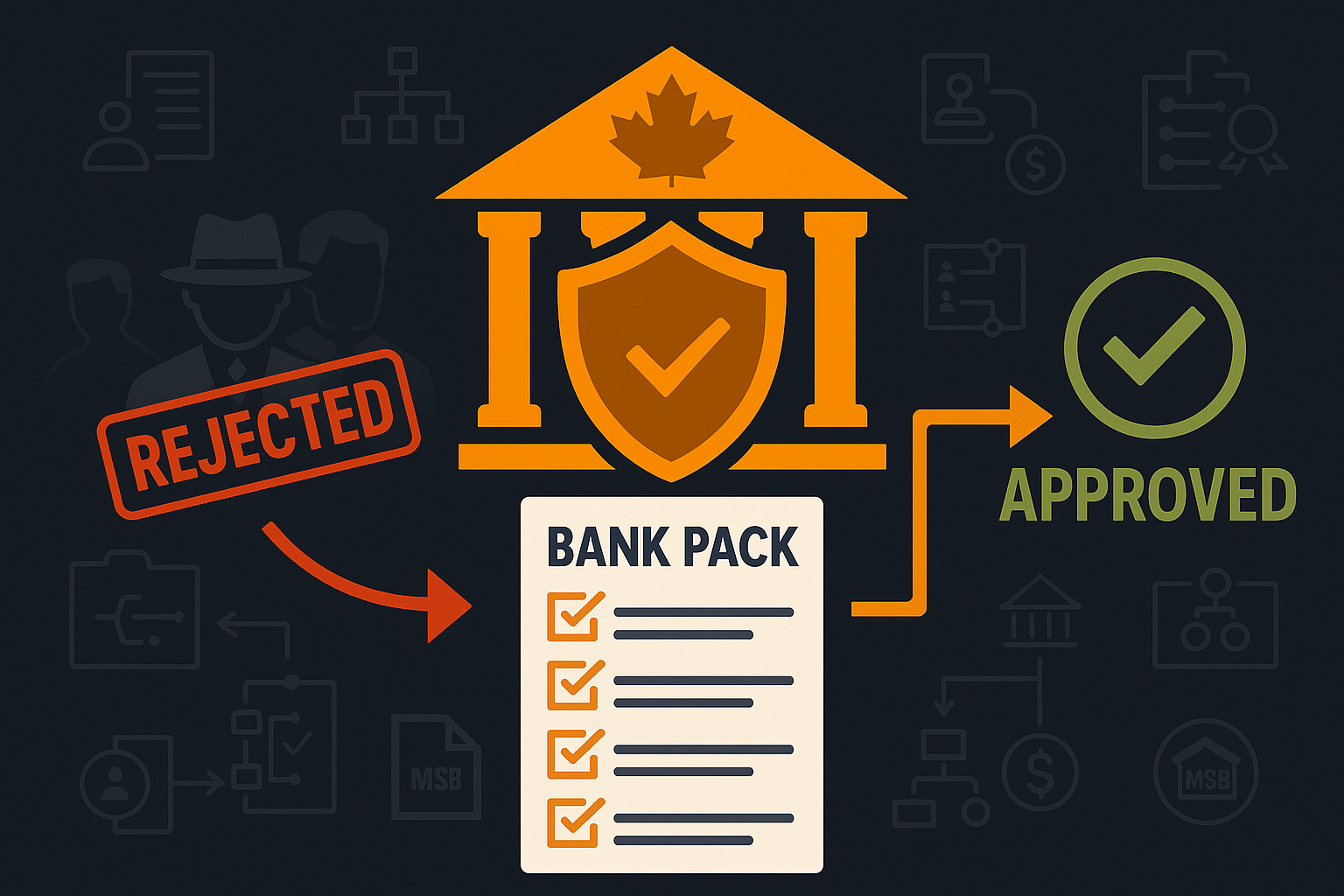For most FinTech startups and MSBs, landing a bank account with a Big 5 Canadian bank—RBC, TD, Scotiabank, BMO, or CIBC—is a major milestone. It signals credibility, opens access to faster payment rails, and often unlocks better banking services.

Many founders quickly discover that getting accepted is not easy.
Canadian Tier 1 banks apply strict risk-based onboarding practices, especially for high-risk sectors like:
-
Foreign exchange dealers
-
Crypto platforms
-
Online remittance startups
-
Payments processors and virtual asset service providers (VASPs)
Even firms with legitimate models and good intentions are often declined without clear explanation. So what does it actually take to qualify?
What Do Big 5 Banks Look For When Assessing FinTechs?
A Strong Compliance Program
The number one requirement is a credible, fully implemented AML compliance program. Banks are under pressure from regulators like OSFI and FINTRAC to avoid servicing high-risk clients who may be exposed to money laundering and terrorist financing.
To assess your risk profile, banks will typically ask for:
-
Your AML compliance program
-
Details about your transaction monitoring system
-
Evidence of a recent AML effectiveness review
-
Your risk assessment and risk-based approach documentation
-
Your CAMLO’s credentials and background
If you haven’t completed your two-year AML review yet, this could be a dealbreaker. Visit Effectiveness Review to learn how AML Incubator can help you get audit-ready.
Regulatory Standing and Licensing
Banks want to know if your business is:
-
Properly registered as a Money Services Business (MSB) with FINTRAC
-
In good standing with no enforcement history
-
Operated under a clear legal structure, such as a Canadian corporation with defined UBOs
If your MSB registration is incomplete or outdated, your chances of onboarding fall sharply. Our MSB Registration service ensures your file meets institutional-grade expectations.
Business Model Clarity
Big 5 banks will ask questions such as:
-
What is your core business activity?
-
Who are your customers?
-
What types of transactions will you process?
-
Are you exposed to jurisdictions with weak AML enforcement?
They want to ensure your business isn’t a front for illicit activity and that you can clearly explain your risk exposure.
Tip: Be prepared to provide flow-of-funds diagrams and sample client onboarding journeys.
Proven Operational Controls
Beyond compliance, banks will assess:
-
How you vet clients (e.g., KYC tools or vendors used)
-
Your approach to fraud detection and sanctions screening
-
Your customer support process and record-keeping systems
If you rely entirely on manual processes or generic SaaS tools, that could raise red flags. Even early-stage startups need to show intentionality and structure.
Who Typically Gets Rejected (and Why)?
Underdeveloped Compliance Program
Startups that treat compliance as an afterthought rarely pass onboarding reviews. If you don’t have a CAMLO, haven’t conducted a review, or don’t understand the PCMLTFA, you’re unlikely to qualify.
See our CAMLO/MLRO Services if you need to appoint a credible compliance lead.
Unclear Ownership or Offshore Structures
Banks are wary of companies with unclear Ultimate Beneficial Ownership (UBO), opaque offshore holdings, or foreign control with no local governance.
Ensure your corporate structure is transparent and supported by legal documentation.
Prior Regulatory Issues
If you’ve received a penalty or have unresolved deficiencies with FINTRAC, your application may be blocked. Remediation should be completed first.
AML Incubator’s Regulatory Remediation offering is built specifically for MSBs trying to rebuild trust with banks and regulators.
What Steps Should You Take Before Applying to a Big 5 Bank?
Step 1: Conduct an Internal Compliance Audit
Before you apply, conduct a readiness check. Confirm that your AML documents are complete, dated, and properly implemented.
If you need help assessing gaps, a formal Effectiveness Review can validate your program before a bank does.
Step 2: Prepare Your Bank Pack
Most Tier 1 onboarding teams will expect a full submission file, often called a “bank pack,” which includes:
-
AML compliance documents
-
Proof of MSB registration
-
Risk-based approach and risk assessment summary
-
Sample transaction flows
-
Compliance officer biography and contact info
Some may also request proof of funding, client onboarding policies, or audited financials if you’re post-launch.
Step 3: Avoid Rushing the Application
Do not submit partial documentation or “promise to provide later” items. It’s better to delay the application by a week and ensure the bank pack is airtight.
Rejections are usually final, and repeated applications can damage your record across the banking system.
Are There Alternatives to the Big 5 Banks?
Yes. If your business is not yet eligible, consider:
-
Tier 2 banks or credit unions
-
Payments aggregators and sponsors
-
Foreign bank branches (with Canadian presence)
-
Tech-forward BaaS providers
That said, none offer the same level of stability, reputation, or scalability as the Big 5. Most growing FinTechs still aim to qualify eventually.
Can a Consultant Help You Get Banked?
Absolutely. Compliance consultants like AML Incubator regularly help companies prepare for onboarding, structure their documentation, and interface with banks behind the scenes.
We’ve worked with MSBs, FX dealers, crypto startups, and remittance platforms across Canada to improve bank readiness and secure key relationships.
If you’re preparing for a Big 5 application or facing repeated rejections, book a call to discuss a tailored support plan.

